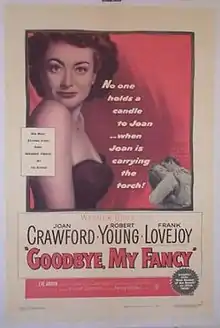Goodbye, My Fancy
Goodbye, My Fancy is a 1951 American romantic comedy film starring Joan Crawford, Robert Young, and Frank Lovejoy. The film was directed by Vincent Sherman and produced by Henry Blanke. Distributed by Warner Bros., the film was based on the 1948 play of same name by Fay Kanin and adapted for the screen by Ivan Goff and Ben Roberts. Breaking the gender stereotypes of its time, the play and film boldly suggested that women had a place outside of the home.[3]
| Goodbye, My Fancy | |
|---|---|
 Original theatrical poster | |
| Directed by | Vincent Sherman |
| Produced by | Henry Blanke |
| Screenplay by | Ivan Goff Ben Roberts |
| Based on | Goodbye, My Fancy: A Comedy in Three Acts 1948 play by Fay Kanin |
| Starring | Joan Crawford Robert Young Frank Lovejoy |
| Music by | Daniele Amfitheatrof |
| Cinematography | Ted D. McCord |
| Edited by | Rudi Fehr |
| Distributed by | Warner Bros. |
Release date |
|
Running time | 107 minutes |
| Country | United States |
| Language | English |
| Budget | $1,312,000[1] |
| Box office | $1,358,000[1][2] |
The plot follows an influential politician who returns to her former college to receive an honorary degree only to find her old flame as the university president.
Goodbye, My Fancy was the third and last cinematic collaboration between Sherman and Crawford, the first two being Harriet Craig and The Damned Don't Cry in 1950.[4]
Plot
Powerful U.S. Representative Agatha Reed (Joan Crawford) returns to her alma mater to receive an honorary degree. Unbeknownst to the college's board of trustees, Agatha was expelled from the school years earlier for participating in an all-night date with a young professor, Dr. James Merrill (Robert Young), who is now the university president. The romantic fires are rekindled when the two meet. Matt Cole (Frank Lovejoy), a photographer from Life magazine who loves Agatha, believes her feeling for Merrill is simply an unresolved holdover from her girlhood and follows her to the school.
Agatha becomes embroiled in a university matter over progressive teaching methods with Dr. Pitt (Morgan Farley), board trustee Claude Griswold (Howard St. John) and his wife Ellen Griswold (Lurene Tuttle). A film Agatha made about the dangers of restricting intellectual freedom is to be shown on campus to celebrate her legacy, but the reactionary Griswold forces Merrill to cancel the showing. Merrill will not stand up to Griswold, and though Merrill consents to show the film if Agatha's expulsion is not revealed, he lies to his daughter about the reason why. After a series of misunderstandings, Agatha realizes she belongs with Cole and should forget the way she fancied Merrill.
Cast
- Joan Crawford – Agatha Reed
- Robert Young – Doctor James Merrill
- Frank Lovejoy – Matt Cole
- Eve Arden – Miss 'Woody' Woods
- Janice Rule – Virginia Merrill
- Lurene Tuttle – Ellen Griswold
- Howard St. John – Claude Griswold
- Viola Roache – Miss Shackelford
- Ellen Corby – Miss Birdshaw
- Morgan Farley – Doctor Pitt
- Virginia Gibson – Mary Nell Dodge
- John Qualen – Professor Dingley
Production
Director Vincent Sherman received a blistering memo from studio head Jack L. Warner about running over budget: "After talking to you on the telephone last night, Friday, I am depending on you to finish the picture by next Saturday, November 18th [1950]. As I told you, other companies are making the same type of picture in 21-28-36 days with important casts. As you know, MGM made Father's Little Dividend, with Spencer Tracy, Elizabeth Taylor and Joan Bennett in 21 days and I am sure the Director had the same problems you have had. You will just have to do this. Otherwise, we cannot stand off this type of cost and delay in making a picture. Those days are gone and no one is going to stay on the team unless they can carry the ball. Get in there and finish the picture by next Saturday or before and stop trying for perfection. No one is interested but yourself and I am sure you are not going to pay to see the picture."[4] Large portions of the film were shot at the University of Redlands in Redlands, California.
Reception
The critics were mixed on the success of the film. Variety commented, "Performances are very slick, under Vincent Sherman's direction. Miss Crawford...sustains the romantic, middle-aged congresswoman with a light touch that is excellent."[5] However, Bosley Crowther in The New York Times generally panned the film, writing, "Miss Crawford's errant congresswoman is as aloof and imposing as the capital dome" and "Joan Crawford is working extra hard to make romance and liberalism attractive in the Warner's film version [of the play]. And when Miss Crawford makes a mighty effort to do what she obviously regards as a significant piece of performing, the atmosphere is electrically charged. At least, it is loaded with tension—or a reasonable facsimile thereof—when Miss Crawford herself is posing or parading within the camera's range.[4]
Box office
According to Warner Bros records the film earned $1,130,000 domestically and $228,000 foreign.[1]
DVD release
Goodbye, My Fancy was released on Region 1 DVD on March 23, 2009 from the online Warner Bros. Archive Collection.
References
- Warner Bros financial information in The William Shaefer Ledger. See Appendix 1, Historical Journal of Film, Radio and Television, (1995) 15:sup1, 1–31 p 31 DOI: 10.1080/01439689508604551
- 'The Top Box Office Hits of 1951', Variety, January 2, 1952
- Barlow, Judith E. (2001). Plays by American Woman: 1930-1960. New York: Applause Theatre Book Publishers. p. xvii. ISBN 1-55783-164-5.
- "Goodbye, My Fancy". Turner Classic Movies. Retrieved January 26, 2014.
- Quirk, Lawrence J.. The Films of Joan Crawford. The Citadel Press, 1968.